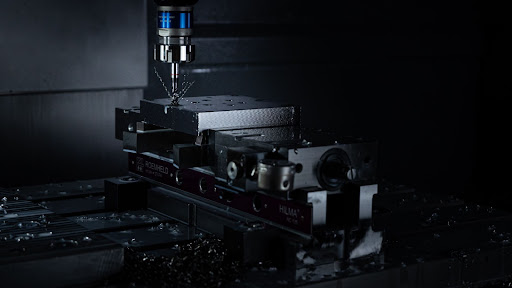History of Laser Machines | Invention & First Use – OMTech Laser
Many people associate lasers with sci-fi movies, particularly the famous lightsabers used in Star Wars. It is true that lasers frequently appear in popular culture, but laser technology is also widely used by various industries to cut and engrave materials as part of their production processes. People do not realize how frequently they come across products created with laser machines.
Although laser cutting appears to be a contemporary technology, its origins might amaze you. The foundation of the first laser can be found in the theoretical work of Einstein. Then it followed a remarkable path and went on to become the higher power lasers used across many industries today.
Let’s read about the basic concept of laser cutting technology and its history.
This Article Contains:
|
What Is Laser Cutting?
Hard materials can be cut or engraved by melting, burning, or vaporizing the materials. This technology is called laser cutting. The method can be used to drill holes or cut shapes in metal and other materials in a production line. It has numerous industrial uses in diverse industries. Laser cutting is also a creative method used to carve decorative patterns on surfaces. With the help of the best laser engraving machines, you can execute a design perfectly.
The main benefit of laser machine technology is its accuracy; for pin-point precision, the high power beam is concentrated through a laser cutting nozzle. Nowadays, sophisticated designs may be made with an industrial laser, thanks to the usage of CAD technology in laser cutting.
How Does Laser Cutting Work?
A laser works by stimulating the atoms in a solid, liquid, or gas medium. This calls for an energy pump, which may be a second laser or even an electrical current. Light is produced as the medium’s atoms begin to absorb energy. By positioning a mirror at each end of the medium to create an optical cavity, this light is focused.
A laser beam is focused onto sheet metal or similar hard material to create a cut. The focus of the laser beam can be changed by experts using lenses, mirrors, and pressurized gases such as carbon dioxide. After the material is removed by the narrow beam’s burning or melting, the technician can move the laser cutting machine head to the next spot.
Who Invented Laser Cutting?
When Albert Einstein developed his hypothesis of “stimulated emission of radiation,” which forms the basis of the current laser, the history of laser cutting began. He postulated that when electrons absorb enough energy to advance an energy level within an atom, they may produce photons.
Gordon Gould, a scientist, developed Einstein’s theory in 1959. He proposed that light could be amplified by using the stimulated emission of radiation. Light Amplification by Stimulated Emission of Radiation, or LASER for short, is the name of his theory.
The first functional laser was created by Theodore Maiman in a California lab in 1960. Despite the fact that many of his contemporaries couldn’t find a use for his ruby laser, he used synthetic ruby to produce a deep red beam. In fact, the public viewed the technology with skepticism and even distrust and labeled it “a solution seeking for a problem.” But many scientists, particularly those working at Bell Labs in New Jersey, saw Maiman’s invention’s potential.
In 1964, a scientist at Bell Labs created laser-assisted thermal cutting methods. In order to improve on ruby laser cutting in terms of speed and efficiency, Kumar Patel invented a gas laser cutting technique using a carbon dioxide combination. Later that year, J.E. Geusic, a coworker at Bell Labs, developed the crystal laser technique. The invention attracted the public’s interest, and it was used in a famous scene in the 1964 film Goldfinger, in which the movie’s antagonist attempted to use a laser beam to split James Bond in half.
First Use of a Laser Cutter
The Western Engineering Research Center in Buffalo, New York, was the first organization to use laser cutting in 1965. The team was looking for a more effective method of producing electrical wires. Diamond dies were then used by manufacturers to extrude metal wire, and it was costly, time-consuming, and challenging to drill the die holes.
To drill the holes more quickly, the Western Engineering Research Center invented focused laser beam cutting. This was a pivotal point in the development of laser cutting and opened the door for other businesses to investigate the possible applications of laser technology. The focus of the group’s work was largely on learning more about the security of laser beams and their potential health impacts.
History of Laser Cutting Technology
Scientists created the gas laser cutting technique utilizing carbon dioxide not long after the Western Engineering Research Center began using laser cutting technology as a drilling tool. This innovation increased the adaptability of laser cutting technology. The general acceptance of the technique was especially dependent on the creation of lasers that could cut through metals like mild steel.
In 1969, the Boeing Company was the first to commercially use gas laser cutting. Three employees of this company co-wrote a paper that explored the concept of using a carbon dioxide laser to cut Hastelloy, titanium, and ceramic. As a result of this paper, multi-beam laser cutting technology was created, and Boeing began utilizing laser beams as a productive cutting method on its manufacturing lines. In the 1970s, Western Electric began mass-producing cutting equipment that was extensively used in the aerospace sector.
During the 1980s, gas laser cutting became widely used. According to the experts, more than 20,000 industrial laser machines are estimated to have been in use. As a result, the production industries were completely transformed by the use of laser cutting techniques, which marked the start of a new industrial revolution.
Another crucial turning point in the development of laser-cutting machines occurred in 1979. Laser cutting was two-dimensional up until this time. The Italian company Prima Industrie created a 3D laser cutting method that greatly increased the possible uses for laser cutting technology.
Laser Technology Today
Since the Boeing Company began producing laser-drilled dies in the late 1960s, laser cutting has advanced significantly. Nowadays, laser energy is widely used across many industries, particularly in the production of automobiles. With the development of laser cutting technology, thicker and more diverse materials, including ceramic, paper, and even metal, may now be cut using this method. Manufacturers may scale up production while reducing worker hours thanks to the much faster material cutting speeds offered by fiber and CO2 laser cutting systems compared to earlier methods. That is why CO2 laser machines and fiber laser engravers are gaining popularity.
You very likely have items in your home that have been cut or engraved by lasers, so just have a look around. The best laser engraving machines are widely used in a variety of sectors to engrave text or logos on objects, including the letters on your computer’s keyboard.
Take Away
The laser cutting machine is a fascinating technology with an intriguing history. You need the right tools and knowledge to execute the task accurately and effectively. Whether you need CO2 laser machines or fiber cutting laser for cutting or engraving, an experienced and reliable service provider can assist you in finding the right solution for your specific needs. Discuss your requirements and learn how the best laser-cutting equipment can help your business to grow.



